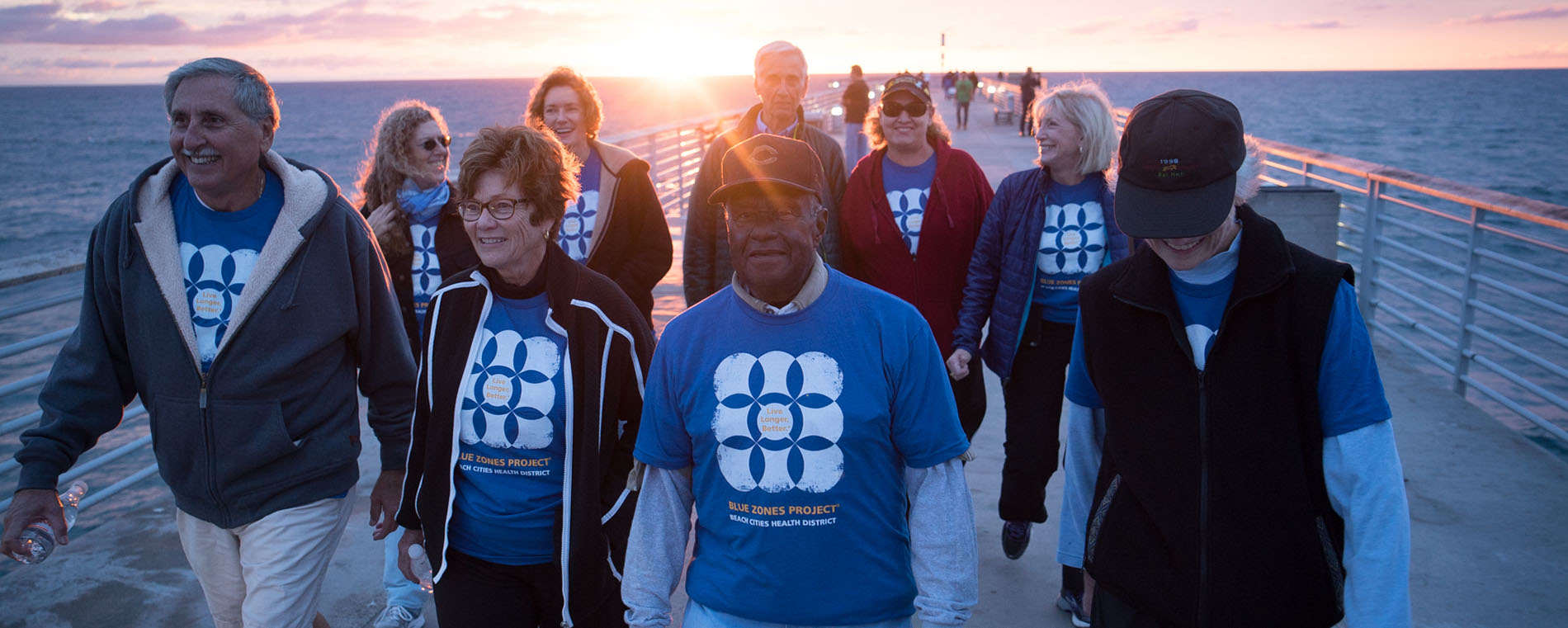For Immediate Release
Media Contact:
Catherine Bem, Beach Cities Health District, (310) 374-3426, Catherine.bem@bchd.org
REDONDO BEACH, Calif. (March 31, 2021) – COVID-19’s impact loomed large in 2020, which proved to be a challenging year for well-being across the United States. The Gallup National Health and Well-Being Index (WBI), which polls adults nationwide on social, purpose, financial, community and physical well-being, reported declining well-being and high levels of stress and worry nationally.
And yet, while the Beach Cities – Hermosa Beach, Manhattan Beach and Redondo Beach – felt the impacts of the pandemic, they also experienced a significant increase in their well-being scores since 2015. Further, the WBI found that Beach Cities residents who engaged with the Blue Zones Project®, a community health initiative implemented by Beach Cities Health District (BCHD), have greater well-being overall. This pattern was observed in every Blue Zones Community®, in which the analysis was conducted, including Fort Worth, Texas, Hawaii and Klamath Falls, Oregon.
BCHD has been implementing the nationally acclaimed Blue Zones Project locally in the Beach Cities since 2010. Born from extensive research in the five areas of the world where people live the longest lives (coined “Blue Zones”), the project aspires to make the healthy choice the easy choice for people by purposefully engineering health into environments where they live, work, learn and play. Engagement with the Blue Zones Project in the Beach Cities reaches 23 percent among those who are aware, and one out of seven adults report it has a positive impact on their community.
Dan Witters, research director of the Well-Being Index, who has managed the WBI since 2009, notes the positive impact the Blue Zones Project can have on people who may not necessarily even be familiar with it. The key is that it surrounds people with healthy options — healthy menu items at local restaurants, policies that create infrastructures for active lifestyles like bath paths and walkways, and community programming to offer people opportunities to connect with others and find their life’s purpose.
“The Blue Zones Project paradigm demonstrates to us that you don’t have to be familiar or directly involved to still see the improvement. Since 2010, the adult population of the Beach Cities, regardless of whether or not they have heard of the Blue Zones Project or involved themselves in its activities, have had significant improvement in many aspects of well-being and at levels that have often greatly exceeded changes in the same metrics at the state or national levels,” says Witters.
Overall, it has been proven that residents who are aware of and engaged in the Blue Zones Project enjoy statistically significant health benefits in the areas of overall, community, financial, social and purpose well-being.
WBI data collected from Sept. 7, 2020-Oct. 2, 2020 in the Beach Cities found that the Beach Cities (with a WBI score of 68.3) outdistanced the rest of California (62.2) and the U.S. (61.2).
In fact, the Beach Cities experienced statistically significant improvement in life evaluation, smoking rate, exercise rate, above normal weight (obese + overweight) rate, daily physical pain, strengths usage, residents feeling that they live in a “perfect place” for them and physical appearance.
“Data shows that engaging in our Blue Zones Project programming has a positive impact on well-being,” says Tom Bakaly, CEO for Beach Cities Health District. “We’re in the business of helping people live healthier, happier lives, and we’re starting to see that our mission is paying off. What’s more is the spillover effect — residents who are unfamiliar with the Blue Zones Project still experience healthier lives because of the health initiatives it’s put in place. In addition to physical health, we’re also focusing on mental health —we’ve seen a growing need and we’re here to address it.”
The WBI detected that large majorities of residents in the Beach Cities have experienced increased stress due to the pandemic, economic shutdown and protests and civil unrest related to racial injustice. BCHD has provided a number of services to support the community during this time including, running essential errands and delivering meals for older adults and other at-risk populations, providing information via social media, its website (bchd.org) and its Assistance, Information & Referral line, operating a COVID-19 testing site for the public and a COVID-19 vaccination site for local educators and offering virtual programming to keep the community connected.
BCHD has established itself as a resource hub and two-thirds of Beach Cities residents are familiar with the District. In addition, favorability among those who are familiar is at 55 percent (41 percent are neutral, and 4 percent have an unfavorable opinion) and 40 percent are involved in BCHD programming.
For more information about the Blue Zones Project in the Beach Cities, please visit www.bchd.org/bzp.
###
About Beach Cities Health District
Beach Cities Health District (BCHD) is a healthcare district focused on preventative health and serves the communities of Hermosa Beach, Manhattan Beach and Redondo Beach. Established in 1955 as a public agency, it offers an extensive range of dynamic health and wellness programs, with innovative services and facilities to promote health and prevent diseases across the lifespan. BCHD also operates AdventurePlex, a health and fitness facility where kids play their way to good health, and the Center for Health & Fitness, a comprehensive fitness center that is the only Medical Fitness Association-certified facility in California. Visit www.bchd.org or call (310) 374-3426 for more information.




